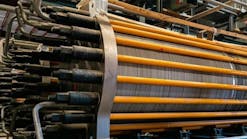Barry West Shige Miyazaki
Bureau of Resource Sciences
Canberra, Australia
Two of the offshore areas recently released for exploration bids by the Australian government are NT94 1 and NT94 2 covering 23,000 sq km in the oil producing Bonaparte basin off northwestern Australia 300 km northwest of Darwin (Fig. 1).
Three wells have been drilled in the two areas, including Evans Shoal 1 which made a gas discovery currently considered to be non-commercial.
Substantial regional seismic surveying was undertaken in the region prior to 1978, and between 1985 and 1987 an additional 2,500 km of good quality, semi detailed and detailed seismic data were obtained in the two release areas.
The results of a study by the Australian Bureau of Resource Sciences (BRS) have been synthesized into the Evans Shoal Area Bulletin and Data Base. BRS interprets the available geochemical and maturation data to indicate that potential source rocks are present in the Jurassic Plover formation and Flamingo group and the Cretaceous Bathurst Island group.
The Malita graben, a northeast trending low between the Sahul platform to the northwest and Darwin shelf to the south, provides the main depocenter and source "kitchen" area.
AREA GEOLOGY
The Plover formation is a fluvial to nearshore deposit, and although most of the organic material is likely to have been derived from terrigenous plant debris, the distribution of sapropelic material increases toward the major depocenter. With average TOC values of 0.37-2.02% and HI values of 7-338, the Plover formation contains intervals of potentially fair to good oil source rocks.
The Flamingo group represents a deltaic to deep marine sequence deposited in a synrift setting, giving rise to major variations in facies and thickness, and presumably, source potential. Average TOC values of 0.45-2.72% and HI values of 22-303 indicate the sequence has intervals of potentially good oil source.
Near the margins of the Malita graben, both the Plover formation and Flamingo group source rocks appear to have entered the oil window by the Late Cretaceous, and after major structuring and the deposition of the regional seal.
The lower part of the Cretaceous Bathurst Island group is a transgressive sequence of marine siltstones, shales and limestones. Average TOC values of 0.37-0.81% and HI values of 22-202 indicate the sequence contains intervals that may be a good gas source with some oil potential. Maturation data indicate the sequence had only entered the early generation oil phase by the Late Cretaceous.
Hydrocarbon shows encountered in the Jurassic and Cretaceous sequences together with the discovery of gas in Evans Shoal 1 in 1988 and the discovery of oil at Elang 1 in February 1994 in the Australia Indonesia Zone of Cooperation to the west, support the interpretation of effective generation and migration in the region.
Good reservoir quality sandstones have been identified in the Jurassic Plover formation and Flamingo group, and the Cretaceous Bathurst Island Group. When combined with the variety of structural and stratigraphic traps, these offer a number of potential play types in this relatively unexplored part of the Bonaparte basin.
PLAY TYPES
Five play types have been identified, some of which offer considerable potential but as yet are untested by drilling. Faulted anticlines and broad, low relief anticlinal drape over tilted fault blocks have provided the major exploration targets to date, including the Evans Shoal gas discovery.
A number of similar features with potential reservoirs in Jurassic age sands remain undrilled. Tilted fault blocks, and turbidite fan sands, occurring along the southern margin of the Malita graben also offer suitable structural and stratigraphic traps respectively in Jurassic sandstones.
The porosity of the Jurassic reservoirs rapidly diminishes at depths greater than 3,500 m, but at shallower depths close to the graben margins, porosities of 15-30% can be expected. Early Cretaceous fractured carbonates have yielded gas shows in several wells in the region, and may provide a secondary exploration target.
Maastrichtian age sands with thicknesses of 158 583 m, and log derived porosities of between 9 33% have been intersected by most wells in the region at depths of 650 1,550 m. They have been interpreted as inner shelf to coastal plain sands around the basin margins, where they are medium to coarse grained, sub rounded and glauconitic, but within the Malita graben, they are clean, fine to medium or coarse, frosted and well rounded, and appear to have been reworked.
BRS believes they represent slope or basin floor fan sands (Fig. 2), and offer a potential new play type in this region. Hydrocarbon charge is likely to be from the lower part of the Bathurst Island group, with reactivated faults providing the migration pathways.
The density of exploration wells in the release areas is approximately one well per 7,700 sq km. Additionally, source rock and reservoir data are only available from approximately 300 and 25 sample points, respectively, irregularly spaced in the three wells. Data from these and surrounding wells, together with reinterpretation of selected seismic data were included in the BRS study, which points out the need for more modern seismic and more drilling in this underexplored, and structurally and stratigraphically complex area.
GAS, OIL POTENTIAL
In summary, data indicate that while the Jurassic section has some potential for oil, the lower part of the Cretaceous Bathurst Island group is more likely to have generated gas although there is some potential for oil. Reservoir quality sands occur as both structural and stratigraphic traps in the Jurassic and Cretaceous sections.
Large anticlinal drape and faulted structures mapped at the base of the Bathurst Island group remain undrilled, and the thick and widespread Maastrichtian sands offer considerable potential as stratigraphic traps. BRS notes that the potential for further gas development in Australia is likely to expand into the next century, increasing the demand for gas exploration, and the recent oil discovery at Elang 1 in the Australia Indonesia Zone of Cooperation enhances the opportunity for further oil discoveries in the region.
Copyright 1994 Oil & Gas Journal. All Rights Reserved.

